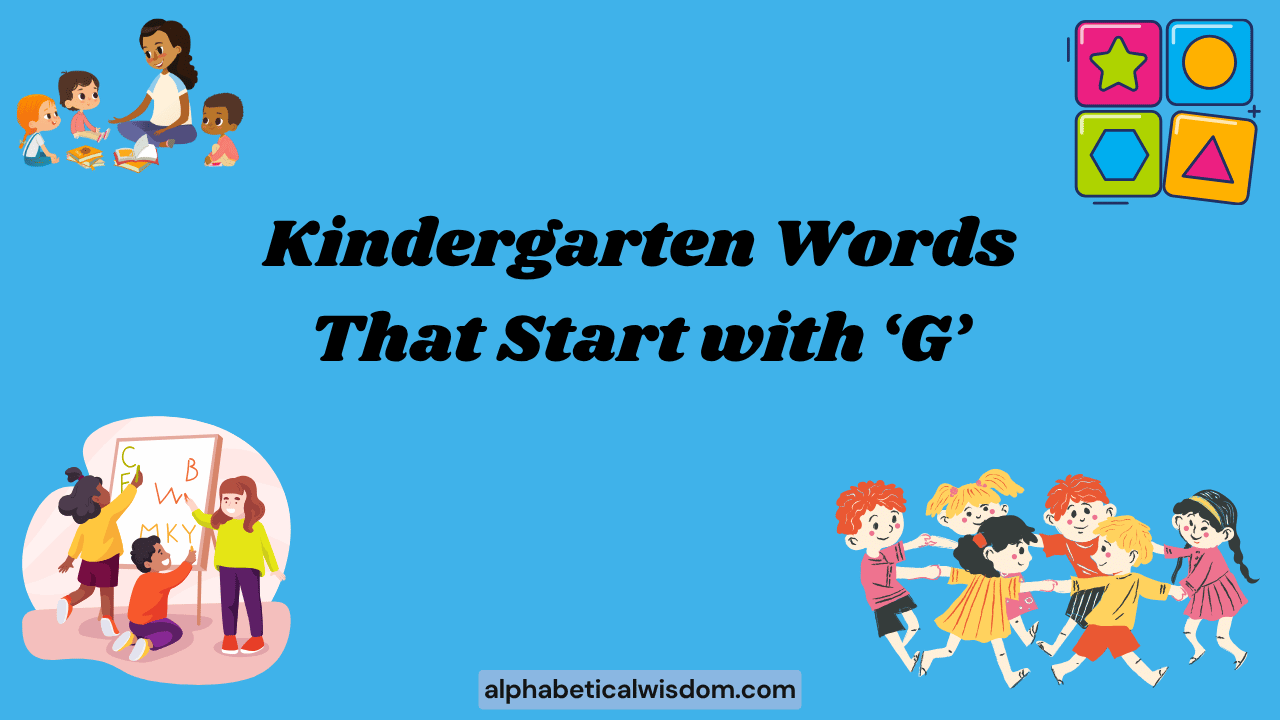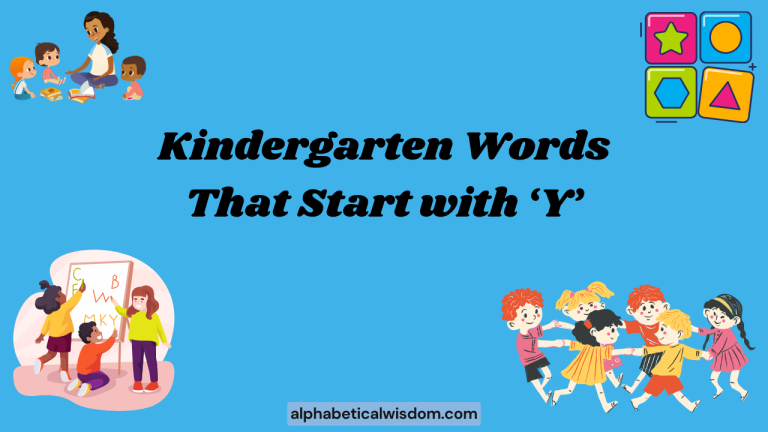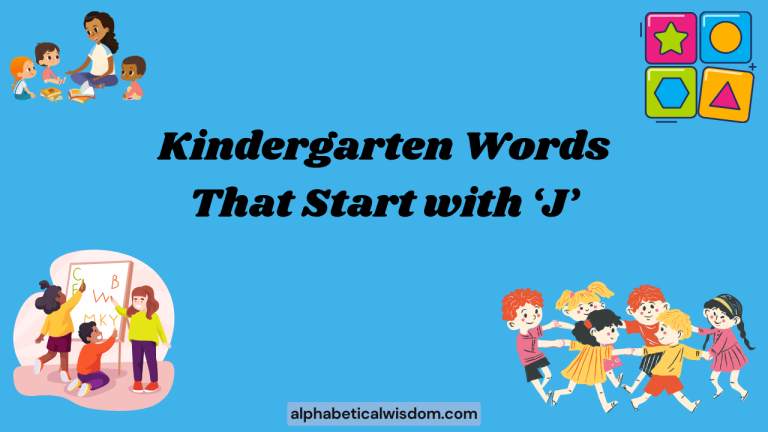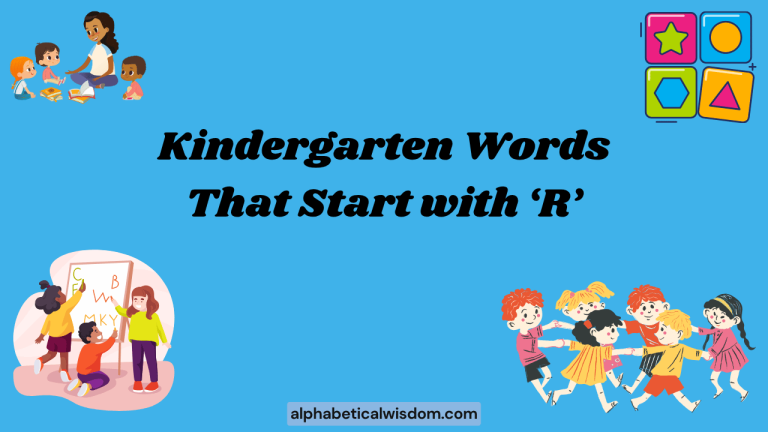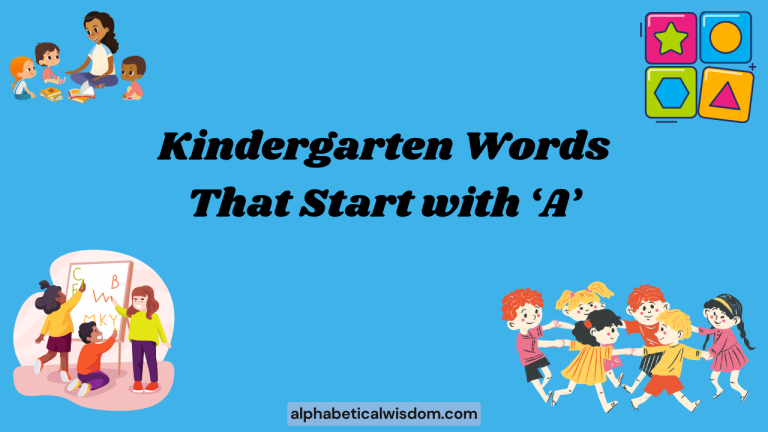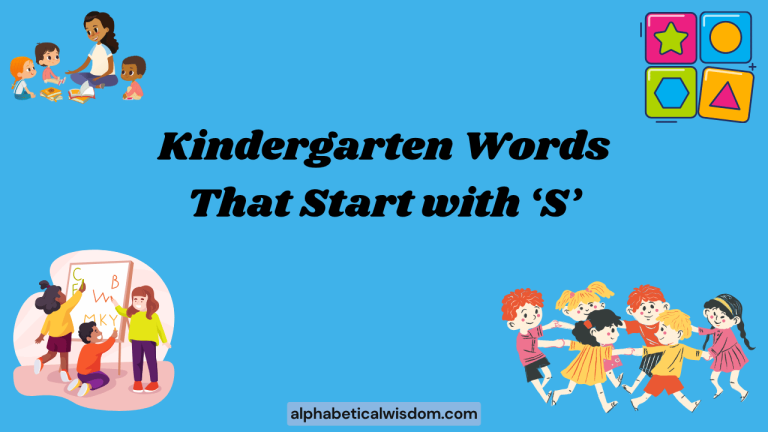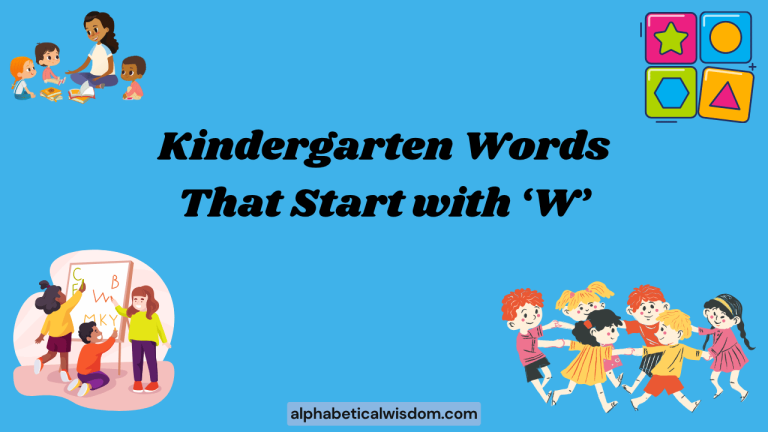Kindergarten Words Starting With G: A Comprehensive Guide
Understanding words that start with the letter ‘G’ is a crucial step in a kindergartner’s literacy journey. These words form the building blocks of early reading and writing skills, expanding vocabulary and fostering effective communication.
This guide offers a structured approach to learning ‘G’ words, benefiting educators, parents, and young learners alike by providing clear definitions, practical examples, and engaging exercises.
Table of Contents
- Introduction
- Definition of Kindergarten Words Starting With G
- Structural Breakdown of ‘G’ Words
- Types of ‘G’ Words for Kindergarten
- Examples of Kindergarten Words Starting With G
- Usage Rules for ‘G’ Words in Sentences
- Common Mistakes with ‘G’ Words
- Practice Exercises
- Advanced Topics: Exploring ‘G’ Sounds and Spelling
- Frequently Asked Questions (FAQ)
- Conclusion
Introduction
The letter ‘G’ is a versatile consonant that appears in many common words. For kindergarteners, mastering words that begin with ‘G’ is essential for building a strong foundation in phonics and vocabulary.
Recognizing and using these words helps young learners develop reading fluency, improve spelling skills, and enhance their overall communication abilities. This article provides a comprehensive guide to ‘G’ words, offering definitions, examples, usage rules, and practice exercises to support effective learning.
Definition of Kindergarten Words Starting With G
Kindergarten words starting with ‘G’ are basic vocabulary terms that are typically introduced to children in their first year of formal schooling. These words are chosen for their simplicity, relevance to a child’s world, and phonetic regularity.
They are designed to be easily recognizable and pronounceable, helping children build confidence in their reading and writing abilities. These words cover a range of topics, including animals, objects, actions, and descriptive terms.
The primary function of these words is to expand a child’s lexicon, enabling them to understand and express themselves more effectively. In the context of early literacy, ‘G’ words serve as stepping stones to more complex vocabulary and grammatical structures.
They help children grasp the relationship between letters and sounds, a fundamental skill for decoding written text.
Classification of ‘G’ Words
Words beginning with ‘G’ can be classified into different parts of speech. For kindergarteners, it’s important to initially focus on simple nouns, verbs, and adjectives.
- Nouns: These are words that represent people, places, things, or ideas (e.g., goat, garden, game).
- Verbs: These are action words that describe what someone or something is doing (e.g., go, give, grow).
- Adjectives: These are descriptive words that modify nouns, providing more information about them (e.g., good, green, great).
Function of ‘G’ Words
‘G’ words function as building blocks in sentences, helping children construct meaningful statements and questions. They enable young learners to describe their environment, express their needs and desires, and engage in simple storytelling. For example, a child might say, “The goat is in the garden,” using ‘G’ words to convey a basic idea.
Contexts of ‘G’ Words
‘G’ words are used in various contexts relevant to kindergarteners, including:
- Home: Game, gift, grandma, grandpa
- School: Group, grade, glue
- Outdoor Activities: Grass, garden, go
- Animals: Goat, goose, goldfish
Structural Breakdown of ‘G’ Words
Understanding the structure of ‘G’ words involves recognizing the initial ‘G’ sound and how it combines with other letters to form a word. Typically, the letter ‘G’ is followed by a vowel, creating a distinct sound.
The structure of these words is often simple, consisting of three to five letters, making them easier for young children to decode and spell.
The phonetic sound of ‘G’ can vary depending on the letters that follow it. Generally, ‘G’ has a hard sound (as in goat) when followed by vowels like ‘a,’ ‘o,’ or ‘u.’ However, it can have a soft sound (like ‘J’) when followed by ‘e,’ ‘i,’ or ‘y’ (though this is less common in basic kindergarten words). Recognizing these variations helps children develop more advanced phonetic awareness.
Phonetic Patterns
Common phonetic patterns in ‘G’ words include:
- G + Vowel: Go, game, get
- G + Consonant + Vowel: Grass, great, grow
Syllable Structure
Most kindergarten ‘G’ words are single-syllable words, making them easier to pronounce and remember. For example, gift, go, and green are all single-syllable words. Understanding syllable structure aids in decoding and spelling.
Types of ‘G’ Words for Kindergarten
Kindergarten ‘G’ words can be categorized based on their part of speech, phonetic sound, and thematic relevance. This categorization helps in creating targeted learning activities and reinforcing vocabulary acquisition.
Nouns Starting With G
Nouns represent objects, people, places, or ideas. Introducing nouns that start with ‘G’ helps children label and describe their environment.
Verbs Starting With G
Verbs describe actions. Using verbs that start with ‘G’ encourages children to express what they and others are doing.
Adjectives Starting With G
Adjectives describe qualities or characteristics. Introducing adjectives that start with ‘G’ helps children add detail to their descriptions.
Examples of Kindergarten Words Starting With G
Below are extensive examples of kindergarten words starting with ‘G,’ categorized by part of speech. These examples are designed to enhance understanding and provide a solid foundation for vocabulary acquisition.
Nouns Starting with G
The following table provides examples of nouns that start with the letter ‘G’, which are suitable for kindergarten-level vocabulary. Each noun is accompanied by a simple sentence to illustrate its usage in context.
| Word | Example Sentence |
|---|---|
| Game | We play a fun game. |
| Gift | I got a gift for my birthday. |
| Girl | The girl is playing with a doll. |
| Goat | The goat eats grass. |
| Garden | We grow flowers in the garden. |
| Glue | I use glue to stick paper together. |
| Grapes | I like to eat green grapes. |
| Grass | The grass is green. |
| Grandma | I love my grandma. |
| Grandpa | My grandpa tells me stories. |
| Gate | Open the gate to enter. |
| Ghost | The ghost is scary. |
| Gingerbread | I like to eat gingerbread cookies. |
| Globe | The globe shows all the countries. |
| Gold | The crown is made of gold. |
| Goldfish | I have a goldfish in a bowl. |
| Goose | The goose swims on the pond. |
| Gorilla | The gorilla is a big ape. |
| Gown | She wore a beautiful gown. |
| Guitar | He plays the guitar. |
| Gum | I chewed a piece of gum. |
| Gun | The toy gun is for playing. |
| Gulf | The ship sailed through the gulf. |
| Gully | The water flowed through the gully. |
| Gumbo | We ate gumbo for dinner. |
Verbs Starting with G
The following table provides examples of verbs that start with the letter ‘G’, suitable for kindergarten-level vocabulary. Each verb is accompanied by a simple sentence to illustrate its usage in context.
| Word | Example Sentence |
|---|---|
| Go | We go to school every day. |
| Give | I give a present to my friend. |
| Grow | Plants grow in the garden. |
| Grab | Grab your coat before we go outside. |
| Greet | I greet my teacher in the morning. |
| Giggle | The joke made her giggle. |
| Glow | The stars glow at night. |
| Guard | The dog guards the house. |
| Guess | Guess what I have in my hand! |
| Gallop | The horse gallops across the field. |
| Gaze | I gaze at the stars in the sky. |
| Gather | We gather around the campfire. |
| Get | I get a sticker for good work. |
| Glide | The bird glides through the air. |
| Glimpse | I glimpse a deer in the forest. |
| Gnaw | The mouse gnaws on the cheese. |
| Govern | The leader governs the country. |
| Grade | The teacher grades our papers. |
| Grant | I grant you your wish. |
| Grate | We grate the cheese for the pizza. |
| Grip | Grip the rope tightly. |
| Groan | I groan when I am tired. |
| Groom | I groom my pet cat. |
| Ground | The airplane is grounded due to the storm. |
| Guarantee | I guarantee you will have fun. |
Adjectives Starting with G
The following table provides examples of adjectives that start with the letter ‘G’, suitable for kindergarten-level vocabulary. Each adjective is accompanied by a simple sentence to illustrate its usage in context.
| Word | Example Sentence |
|---|---|
| Good | She is a good girl. |
| Green | The grass is green. |
| Great | We had a great time at the park. |
| Glad | I am glad to see you. |
| Gentle | Be gentle with the kitten. |
| Giant | The tree is giant. |
| Gifted | She is a gifted artist. |
| Gleaming | The car is gleaming after the wash. |
| Glorious | The sunset is glorious. |
| Golden | The leaves are golden in the fall. |
| Gorgeous | The flowers are gorgeous. |
| Graceful | The dancer is graceful. |
| Grand | It was a grand adventure. |
| Grateful | I am grateful for my friends. |
| Gray | The sky is gray today. |
| Greedy | The boy is greedy for more candy. |
| Grim | The weather is grim and rainy. |
| Groovy | The music is groovy. |
| Grounded | The airplane is grounded due to the storm. |
| Guarded | The treasure is guarded by a dragon. |
| Guiding | The light is guiding us home. |
| Gullible | He is gullible and believes everything. |
| Gummy | The candy is gummy. |
| Gusty | The wind is gusty today. |
| Gutsy | She is gutsy and brave. |
Usage Rules for ‘G’ Words in Sentences
Using ‘G’ words correctly in sentences involves understanding basic grammar rules, such as subject-verb agreement and proper noun usage. It also requires awareness of the different forms of verbs (e.g., present, past, future) and how they change the meaning of a sentence.
Subject-Verb Agreement
Subject-verb agreement means that the verb in a sentence must agree in number with the subject. If the subject is singular, the verb must be singular; if the subject is plural, the verb must be plural.
For example:
- Singular: The goat eats grass.
- Plural: The goats eat grass.
Noun Usage
Nouns can be singular or plural. Plural nouns often end in ‘-s.’ Proper nouns (names of specific people, places, or things) should be capitalized.
For example:
- Singular: I have a gift.
- Plural: I have many gifts.
- Proper Noun: Grandma is coming to visit.
Verb Tenses
Verbs can be used in different tenses to indicate when an action takes place. Common tenses for kindergarteners include present, past, and future.
For example:
- Present: I go to school.
- Past: I went to school yesterday.
- Future: I will go to school tomorrow.
Common Mistakes with ‘G’ Words
Young learners often make predictable mistakes when using ‘G’ words. Addressing these errors explicitly can help reinforce correct usage and improve understanding.
Mispronunciation
Children may mispronounce ‘G’ words due to unfamiliarity with the sounds or difficulty with articulation. Common mispronunciations include confusing the hard and soft ‘G’ sounds or omitting the initial ‘G’ sound altogether.
Correct: Goat (pronounced with a hard ‘G’)
Incorrect: Oat (omitting the ‘G’ sound)
Spelling Errors
Spelling errors are common, especially with words that have similar sounds but different spellings. For example, children might confuse ‘grass’ with ‘glass’ or ‘grow’ with ‘glow.’
Correct: The grass is green.
Incorrect: The glass is green.
Incorrect Word Usage
Children may use ‘G’ words incorrectly in sentences due to a lack of understanding of their meaning or grammatical function. For example, they might use a noun as a verb or an adjective as a noun.
Correct: I give a gift.
Incorrect: I gift a give.
Practice Exercises
These practice exercises are designed to reinforce understanding and promote correct usage of kindergarten ‘G’ words. Each exercise includes a variety of question types to cater to different learning styles.
Exercise 1: Fill in the Blanks
Complete the following sentences with the correct ‘G’ word from the word bank. Word Bank: (goat, garden, game, gift, girl)
| Question | Answer |
|---|---|
| 1. The ______ is playing in the park. | girl |
| 2. We grow flowers in the ______. | garden |
| 3. I got a ______ for my birthday. | gift |
| 4. The ______ eats grass. | goat |
| 5. Let’s play a fun ______. | game |
| 6. The little ______ is wearing a pink dress. | girl |
| 7. My mom plants vegetables in the ______. | garden |
| 8. Thank you for the wonderful ______. | gift |
| 9. The ______ jumped over the fence. | goat |
| 10. We love to play this ______ together. | game |
Exercise 2: True or False
Indicate whether the following sentences are true or false.
| Statement | Answer |
|---|---|
| 1. ‘Goat’ is a verb. | False |
| 2. ‘Green’ is an adjective. | True |
| 3. ‘Game’ is a noun. | True |
| 4. ‘Give’ is an adjective. | False |
| 5. ‘Garden’ is a verb. | False |
| 6. ‘Grandma’ is a noun. | True |
| 7. ‘Grow’ is a noun. | False |
| 8. ‘Good’ is an adjective. | True |
| 9. ‘Grass’ is a verb. | False |
| 10. ‘Go’ is a verb. | True |
Exercise 3: Multiple Choice
Choose the correct ‘G’ word to complete each sentence.
| Question | Answer |
|---|---|
| 1. I like to eat ______ grapes. (a) blue (b) green (c) red | b) green |
| 2. My ______ tells me stories. (a) grandpa (b) sister (c) brother | a) grandpa |
| 3. We ______ to school every day. (a) play (b) go (c) eat | b) go |
| 4. She is a ______ girl. (a) bad (b) good (c) small | b) good |
| 5. The ______ is in the garden. (a) cat (b) dog (c) goat | c) goat |
| 6. We use ______ to stick paper together. (a) tape (b) glue (c) scissors | b) glue |
| 7. A ______ is a fun activity. (a) work (b) game (c) chore | b) game |
| 8. I received a ______ on my birthday. (a) book (b) gift (c) toy | b) gift |
| 9. ______ grows in the field. (a) flowers (b) grass (c) trees | b) grass |
| 10. I can ______ taller every year. (a) play (b) grow (c) jump | b) grow |
Advanced Topics: Exploring ‘G’ Sounds and Spelling
For advanced learners, exploring the nuances of the ‘G’ sound and its spelling variations can deepen their understanding of phonetics and orthography. This includes examining the soft ‘G’ sound and irregular spellings.
Soft ‘G’ Sound
The letter ‘G’ can have a soft sound (like ‘J’) when followed by ‘e,’ ‘i,’ or ‘y.’ While less common in basic kindergarten vocabulary, introducing this concept early can prevent confusion later on. Examples include words like “ginger” and “giant.”
Irregular Spellings
Some words with the ‘G’ sound have irregular spellings or silent letters. For example, the word “gnaw” starts with a silent ‘G.’ Discussing these exceptions helps children develop a more nuanced understanding of English spelling rules.
Frequently Asked Questions (FAQ)
Here are some frequently asked questions about kindergarten words starting with ‘G,’ along with detailed answers to address common concerns and misconceptions.
- Q: Why is it important for kindergarteners to learn words starting with ‘G’?
A: Learning ‘G’ words is crucial for building a strong foundation in phonics and vocabulary. It helps children recognize letter-sound relationships, improve reading fluency, and enhance their overall communication skills. Mastering these words enables young learners to express themselves more effectively and understand written text.
- Q: What are some strategies for teaching ‘G’ words to kindergarteners?
A: Effective strategies include using visual aids (flashcards, pictures), engaging in interactive games (matching, word searches), and incorporating ‘G’ words into storytelling and creative writing activities. Repetition and positive reinforcement are also essential for successful learning.
- Q: How can parents support their child’s learning of ‘G’ words at home?
A: Parents can support their child by reading books together that feature ‘G’ words, creating ‘G’ word flashcards, and playing word games. Encouraging children to use ‘G’ words in everyday conversations also helps reinforce their understanding and usage.
- Q: What are some common mistakes children make with ‘G’ words, and how can they be corrected?
A: Common mistakes include mispronunciation, spelling errors, and incorrect word usage. These can be corrected through targeted practice exercises, phonetic drills, and explicit instruction on grammar rules and vocabulary definitions. Providing constructive feedback and encouragement is also important.
- Q: How can I make learning ‘G’ words fun and engaging for my child?
A: Make learning fun by incorporating games, songs, and hands-on activities. Use colorful and engaging materials, and create a positive learning environment where children feel comfortable taking risks and making mistakes. Tailor the activities to your child’s interests and learning style.
- Q: Are there any specific resources or websites that can help with teaching ‘G’ words?
A: Yes, many online resources and websites offer interactive games, printable worksheets, and educational videos for teaching ‘G’ words. Look for reputable educational websites and apps designed for early learners.
- Q: When should I introduce the soft ‘G’ sound to my kindergartener?
A: The soft ‘G’ sound (like in “ginger”) can be introduced once your child has a solid grasp of the hard ‘G’ sound (like in “goat”). It’s best to introduce it gradually and provide plenty of examples and practice opportunities.
- Q: How can I assess my child’s understanding of ‘G’ words?
A: You can assess your child’s understanding through informal assessments such as asking them to identify ‘G’ words in a book, spell ‘G’ words, or use ‘G’ words in sentences. Formal assessments such as quizzes or worksheets can also be used, but should be approached in a relaxed and supportive manner.
- Q: What if my child is struggling to learn ‘G’ words?
A: If your child is struggling, be patient and provide extra support. Break down the learning process into smaller steps, use a variety of teaching methods, and focus on building their confidence. If the difficulties persist, consider consulting with a teacher or educational specialist.
- Q: How do ‘G’ words contribute to overall literacy development?
A: ‘G’ words are fundamental building blocks for early literacy. By mastering these words, children develop essential skills in phonics, vocabulary, reading comprehension, and writing. This lays a strong foundation for future academic success and lifelong learning.
Conclusion
Mastering kindergarten words that start with ‘G’ is a significant milestone in a child’s literacy development. This guide has provided a comprehensive overview of ‘G’ words, including definitions, examples, usage rules, and practice exercises.
By understanding these concepts and engaging in regular practice, educators and parents can effectively support young learners in building a strong foundation in phonics and vocabulary.
Remember to use a variety of teaching methods, create a positive learning environment, and tailor the activities to each child’s individual needs and learning style. With consistent effort and encouragement, kindergarteners can confidently expand their vocabulary and develop a lifelong love of reading and writing.
